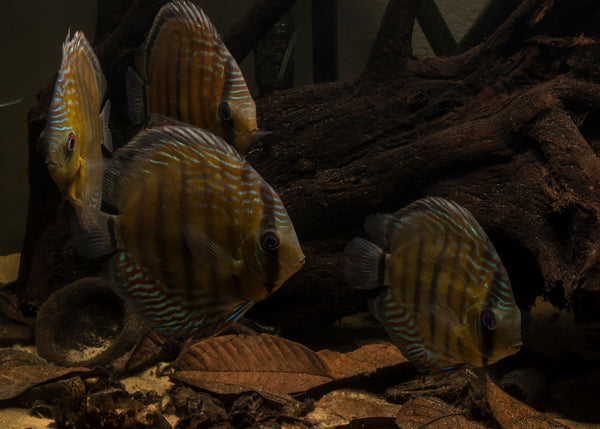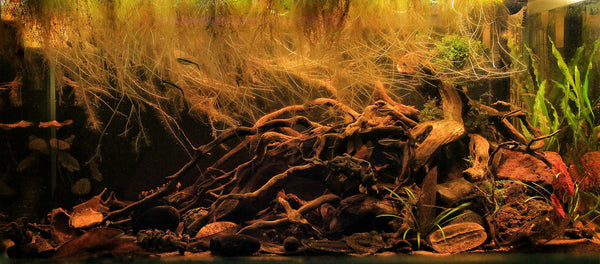- Continue Shopping
- Your Cart is Empty
Water quality and the natural-style botanical aquarium...
There must be a thousand ways to set up an aquarium and operate it. In fact, its probably several times that amount. And no one can ever seem to agree what the "best" way to go is. And that's okay. There are a lot of cool approaches you can try. So, while we might disagree on the best approach or style, we all seem to have a common goal:
Providing the best possible environment for our fishes.
Pretty much every really serious aquarium hobbyist can agree on one thing: It's important to have information about what's going on in his or her aquariums. Observation, collection of data, and interpretation of the information gathered have been keys to our success in so many areas of endeavor in the hobby.

And of course, not being a scientist makes it kind of challenging for me to make all kinds of assertions about water quality and chemistry, so I will at least try to limit this brief discussion to the topic at hand: Water quality and the testing we do.
Now, we kind of have a pretty good "handle" on which tests make the most sense for our pursuits. It's a given that ammonia, nitrite, pH and DKH are the key indicators which most hobbyist will want to know about.

And then, there are the tests which give us information on the quality of the environment we've created- nitrate and phosphate. Nitrate (NO3) is not necessarily considered "toxic" at a specific level, although a typical rule of thumb is to keep readings under 50 mg/l- or better still, 20mg/l or less, for most fishes at various stages of their life cycle.

Although there is no "lethal dose", as indicated above, and many fishes can tolerate prolonged exposure to up to 500 mg/l of nitrate, studies have revealed that prolonged exposure to elevated levels of nitrate may reduce fishes' immunity, affecting their internal functions and resistance to disease.
Many fishes can adapt- to a certain extent- to a gradual increase in nitrate over time, although long-term physiological damage can occur. And of course, some fishes are much more sensitive to nitrate than others, displaying deteriorating overall health or other symptoms at much lower levels..

One of the interesting things about nitrate is that it can and will accumulate and rise over time in the aquarium if insufficient export mechanisms (ie; water exchanges, lack of chemical or biological filtration capacity exist within the aquarium. This, of course, gives the impression that fishes are "doing okay" when the reality is that they are exposed to a long-term stressor. The presence of plants, known for their utilization of nitrate as a growth factor, is also considered a viable way to reduce/export nitrates, along with overall good husbandry (ie; stable fish population, proper feeding technique, etc.)

In our botanical-filled, natural-style aquariums, I have personally never observed/measured high level of nitrate. In fact, with a good husbandry regime in place, undetectable (on a hobbyist-grade test kit, at least) levels of nitrate have been the norm for my systems. I think that the highest nitrate reading I've personally recorded in a botanical-style system which I maintained was around 10 mg/l.
Why is this?
Well, I personally feel that well-maintained systems, including our heavily botanically-influenced ones, offer a significant "medium" for the growth and proliferation of beneficial bacteria species, such as Nitrospira. I have a totally ungrounded "theory" that the presence of botanicals, although in itself a contributor to the the biological load on the aquarium, also is a form of "fuel" to power the identification process- a carbon source, if you will, to elevate levels of biological activity in an otherwise well-maintained system.

Okay, sounds like a lot of cobbled-together "mumbo jumbo", but I think there is something to this. I man, when you think about it, a botanically-rich aquarium, with leaves and other materials, fosters bacteria, fungi, biofilms, and supports crustaceans and other organisms which can consume the botanicals as they breakdown, along with fish wastes and other organics. A sort of "on board" biological filtration system, if you will, with the added benefit that fishes will consume some of these organisms. Perhaps, even the basis for a sort of "food web", something that we know exists in all natural aquatic ecosystems.

The other measure of water quality that most of us should consider is phosphate (PO4). It's a salt of phosphoric acid- an inorganic chemical. It's an essential chemical for the growth of plants, and other living organisms. Phosphate gets a lot of "bad press" in the hobby as a contributor to the growth and proliferation of algae, which it is. However, it's really only half of the equation, as algae only grows if nitrogen is also present...So, it's a contributor to algae issues and overall water quality- not the main culprit.

In the reef hobby, phosphate has been vilified as a growth inhibitor to coral, and all manner of additives, reactors, and removal media have been developed to combat it. The reality, IMHO, is that phosphate- although a great measure of overall water quality, tends not to become a problem in an otherwise well-managed aquarium. It gets into our systems in the first place via food, and will accumulate if mechanisms for its absorption/utilization or removal don't exist.

So, yeah- perform those regular water exchanges.
Oh, and both nitrate an phosphate are present in tap water...so when I espouse the use of an expensive RO/DI unit to pre-treat your tap water, I'm recommending a means to eliminate it at the source, giving you at least a good start. Reverse osmosis/deionization units, albeit somewhat pricy, are, in my opinion, an essential piece of equipment for any serious hobbyist.
In general, the water quality of our botanical-influenced, natural systems is something worthy of a lot of research, experiments, and discussion in our community. There is so much interesting stuff happening in our tanks- and so many things we don't know...Specifically, how very low pH aquariums are best kept biologically stable.
And of course, the function- both biologically and environmentally- of deep leaf litter beds I the aquarium. We have taken our first tentative footsteps beyond what has long been accepted and understood in the hobby, and are starting to ask new question, make new observations, and yeah- even a few discoveries- which will evolve the aquarium hobby in the future.
Stay curious. Stay studious. Stay experimental. Stay bold. Stay diligent...
And Stay Wet.
Scot Fellman
Tannin Aquatics








Scott Fellman
Author